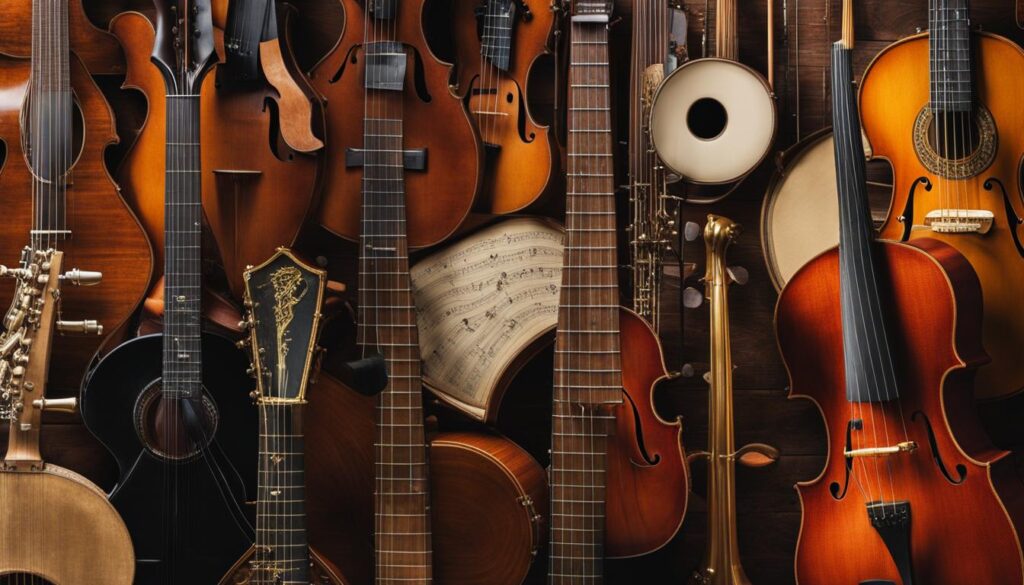We may earn money or products from the companies mentioned in this post.
Music has been an integral part of human culture since ancient times. It has evolved over the years, reflecting the cultural, social, and political changes of each era. From the enchanting melodies of medieval times to the dramatic symphonies of the romantic era, music has continually pushed the boundaries of artistic expression.
In this section, we will explore the history of music and its evolution through different eras. We will uncover the rich cultural significance of music, from the ancient civilizations to the present day. Join us on a fascinating journey through the ages to discover the captivating world of music.
Key Takeaways:
- Music has been an integral part of human culture since ancient times
- It has evolved over the years, reflecting the cultural, social, and political changes of each era
- We will explore the history of music and its evolution through different eras
- From the ancient civilizations to the present day, music holds great cultural significance
- Join us on a fascinating journey through the ages to discover the captivating world of music
The Origins: Exploring Medieval and Renaissance Music
Music has been an integral part of human culture for centuries, with its origins tracing back to the medieval and renaissance periods. These two eras were instrumental in shaping the course of music history, elevating it from a simple form of entertainment to an essential aspect of human life.
Medieval Music: From Chants to Polyphony
The medieval period, spanning from the 5th to the 15th century, was characterized by monophonic music, where a single melody line was sung without any accompanying harmony. One of the most significant genres of medieval music was plainchant, a vocal form of music used for religious purposes in the Catholic Church.
Over time, polyphony emerged, allowing for multiple melodies to be played simultaneously. This revolutionized the musical landscape, opening up a new world of harmonic possibilities. One of the most famous examples of medieval polyphony is the motet, a vocal composition that combined different texts and melodies.
Renaissance Music: Innovation and Creativity
The Renaissance period, which lasted from the 15th to the 17th century, marked a significant shift in music history. This era was characterized by a renewed interest in classical learning and the arts, leading to a surge in musical innovation and creativity.
Renaissance music was marked by increased instrumental music, with the emergence of new instruments like the lute, the harpsichord, and the violin. This period also saw the development of new musical forms like the madrigal, a secular vocal genre that featured intricate harmonies and texts.
The Legacy of Medieval and Renaissance Music
The medieval and renaissance periods were vital in shaping the course of music history. They laid the foundation for the emergence of new musical styles and genres, paving the way for the baroque, classical, and romantic eras that followed.
The influence of medieval and renaissance music can still be felt today, with their legacy evident in the works of contemporary composers and musicians. Their innovation and creativity continue to inspire and enrich the world of music, showcasing the enduring power of this timeless art form.
The Baroque Era: A Flourishing Period of Musical Expression
The Baroque era marked a period of musical innovation and expression that emerged in Italy in the early 1600s and spread throughout Europe. It was a time of great social, political, and cultural change, and music reflected this upheaval, paving the way for the evolution of music.
Defining Features of Baroque Music
Baroque music is characterized by its ornate and elaborate compositions, featuring complex melodies and harmonies. The use of counterpoint, where multiple melodies are played simultaneously, was also a defining feature of the era.
The Baroque period saw the emergence of new musical forms, including the concerto, sonata, and opera. Composers during this time, such as Johann Sebastian Bach and George Frideric Handel, were known for their virtuosic and technically demanding compositions.
The Rise of Opera
One of the most significant developments of the Baroque era was the rise of opera. The first operas were staged in Italy in the late 16th century and quickly gained popularity throughout Europe.
Opera was a collaborative art form that combined music, drama, and staging, and it allowed composers to explore new forms of musical expression. The most renowned opera composer of the Baroque era was undoubtedly Handel, whose operas, including “Giulio Cesare” and “Serse,” continue to be performed today.
The Legacy of the Baroque
The Baroque era laid the foundation for many of the musical forms that we know and love today. The technical mastery and innovation of composers during this period paved the way for the evolution of music in the centuries that followed.
Today, the works of Baroque composers such as Bach, Handel, and Antonio Vivaldi remain popular and influential, showcasing the enduring legacy of this flourishing period of musical expression.
The Classical Era: An Age of Elegance and Symmetry
The classical era of music was a time of elegance and symmetry, lasting roughly from the mid-18th to the early 19th century. The music of this period featured a focus on form and structure, with clear-cut melodies, harmonies, and rhythms.
The Characteristics of Classical Music
One of the most notable characteristics of classical music is its balance and clarity. The music is well-structured, often following a sonata or concerto style, and emphasizes symmetry and proportion. The melodies of classical music are clear and easy to follow, with a focus on repetition and variation to create a familiar, memorable sound.
Another defining feature of classical music is its use of the orchestra. During this era, the orchestra grew significantly in size and complexity, with many new orchestral instruments introduced. This allowed composers to create more nuanced and detailed sounds in their works.
The Most Influential Composers of the Classical Era
Among the most prominent composers of the classical era were Wolfgang Amadeus Mozart, Franz Joseph Haydn, and Ludwig van Beethoven. Mozart, known for his operas, symphonies, and chamber music, was a master of melody and form, creating works that still inspire awe today.
Haydn is often called the “father of the symphony” and was known for his use of humor and drama in his compositions. His works were instrumental in shaping the sound of the classical era.
Beethoven, who bridged the gap between the classical and romantic eras, created some of the most famous works of classical music, including his Ninth Symphony and Moonlight Sonata. His innovative approach to harmony and form laid the groundwork for future musical development.
The Impact of the Classical Era on Music Evolution
The classical era marked a significant shift in the evolution of music. Its emphasis on structure, balance, and clarity set the stage for future musical developments, while its use of the orchestra expanded the possibilities of sound.
Perhaps most importantly, the works created during this era have stood the test of time, remaining popular and beloved centuries after their creation. The classical era of music will always hold a special place in the history of music, and its influence on future generations will continue to be felt for years to come.
The Romantic Era: Passion, Emotion, and Musical Revolution
The Romantic Era, lasting from the late 18th to early 19th century, marked a significant departure from the rationality and order of the Classical era. Romantic composers explored intense emotional expression, exaggerated drama, and a more individualized approach to composition, creating some of the most profound and memorable music known to humanity.
One notable characteristic of Romantic music is its emphasis on melody. Composers like Frederic Chopin and Franz Liszt created beautiful, flowing melodies that have become instantly recognizable. This emphasis on melody was often accompanied by virtuosic solos, demonstrating the incredible range and technical skill of Romantic performers.
Another distinguishing feature of Romantic music was its programmatic nature. Composers like Hector Berlioz and Richard Strauss composed works with explicit stories or narratives. Berlioz’s “Symphonie fantastique,” for instance, tells the story of an opium-induced dream, complete with witches’ sabbaths and a guillotine scene.
Perhaps the most significant contribution of the Romantic era was the symphonic poem, a form that allowed composers like Franz Liszt and Richard Strauss to explore poetry, art, and literature through music. This genre marked an evolution of music, as it combined elements of traditional symphonies and operas with literary and visual inspiration.
“Music is the poetry of the air.” – Jean Paul Richter
Overall, the Romantic era saw a true revolution in musical expression, paving the way for the experimentation and innovation of the 20th century. Its emphasis on emotion, individuality, and programmatic content continues to inspire musicians and listeners today, cementing its place in the history of music.
Conclusion
In conclusion, exploring the timeline of music has provided us with a fascinating look into the evolution of this art form. Throughout the ages, influential artists have shaped and defined music, leaving a lasting impact on the classical and romantic eras as well as on the musical landscape as a whole.
The Classical Era: A Legacy of Elegance and Symmetry
The classical era is a testament to the beauty and perfection of symphonies, sonatas, and string quartets. The works of Mozart, Haydn, and Beethoven brought forth an era of refined elegance and balance, which has continued to inspire and captivate audiences for centuries.
The Romantic Era: A Time of Passion, Emotion, and Musical Freedom
The romantic era marked a significant shift in the evolution of music, as composers like Chopin, Liszt, and Brahms pushed the boundaries of musical expression. Their emotion-filled compositions and dramatic symphonies continue to inspire and influence musicians to this day.
Influential Artists: Shaping the Course of Music History
From the earliest days of music to the present, influential artists have left their mark on this art form. The likes of Bach, Handel, Mozart, Beethoven, and Chopin have all helped shape the course of music history in their own unique way, influencing each era and paving the way for new and innovative forms of musical expression.
With each passing era, music has continued to evolve and adapt, reflecting the cultural, political, and social changes of its time. By exploring the rich history and timeline of music, we gain a deeper appreciation for the power and universality of this art form, reminding us of the remarkable journey that music has taken us on through the ages.
FAQ
What is the history of music?
The history of music dates back thousands of years, with evidence of musical instruments and compositions found in ancient civilizations such as Mesopotamia and Egypt. Over time, music has evolved and diversified, reflecting the cultural, social, and artistic developments of different eras.
What is medieval music?
Medieval music refers to the musical compositions and styles that were prevalent during the Middle Ages, roughly from the 5th to the 15th century. It was characterized by monophonic melodies, primarily vocal compositions, and was often associated with religious institutions and rituals.
What is renaissance music?
Renaissance music refers to the music produced during the Renaissance period, which spanned from the 14th to the 17th century. This era saw a shift towards polyphonic compositions, increased secular music, and the emergence of influential composers such as Josquin des Prez and Giovanni Pierluigi da Palestrina.
What is baroque music?
Baroque music is a style that dominated the Western world from the late 16th to the early 18th century. It is characterized by complex compositions, ornate melodies, and the use of instruments such as the harpsichord and the violin. Famous composers of the baroque era include Johann Sebastian Bach and George Frideric Handel.
What is classical music?
Classical music refers to the music composed in the classical era, which roughly spanned from the mid-18th to the early 19th century. It is known for its structured and balanced compositions, often featuring symphonies, sonatas, and chamber music. Notable classical composers include Wolfgang Amadeus Mozart, Joseph Haydn, and Ludwig van Beethoven.
What is romantic music?
Romantic music is a style that emerged in the early 19th century and continued until the early 20th century. It is characterized by its focus on expressing emotions, using dramatic melodies and powerful symphonies. Famous composers of the romantic era include Frédéric Chopin, Franz Liszt, and Johannes Brahms.
How did music evolve over time?
Music has evolved in numerous ways throughout history. From simple melodies in ancient times to complex compositions and genres in modern times, music reflects the changing tastes, technologies, and societal influences. Each era has contributed to the development and diversification of music as an art form.
Affiliate Disclosure: This post may contain affiliate links. If you purchase through our link, we may receive a small commission, but at no additional cost to you. For more information, please see our Disclosure statement.



